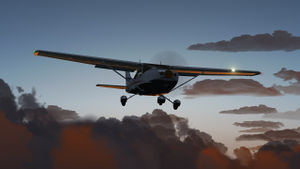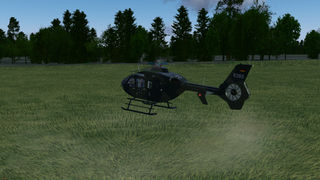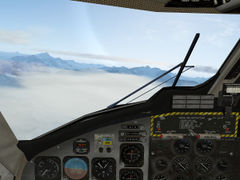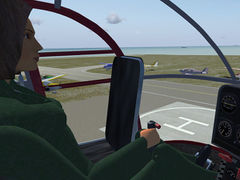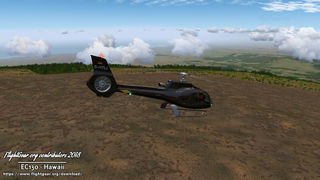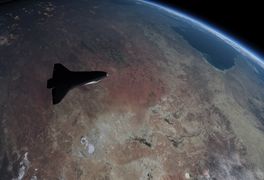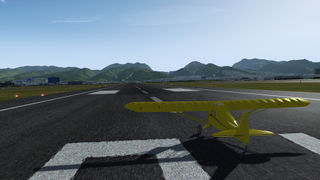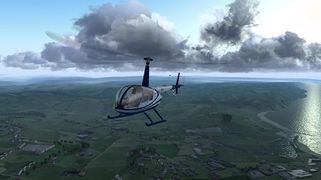Howto:Install aircraft: Difference between revisions
No edit summary |
|||
| (20 intermediate revisions by 11 users not shown) | |||
| Line 1: | Line 1: | ||
{{installing}} | {{installing}} | ||
<!-- Add screenshots of some of the all-round well developed aircraft in FGAddon that have recent screenshots, both to motivate people that are stuck to persist and figure out aircraft installation, and to clue in people just curious about FG or reading the wiki for articles about FG (September 2020) --> | |||
The latest official [[aircraft]] | [[File:Cockpit_full.jpg|thumb|[[Space_Shuttle|Space Shuttle]] cockpit at night (FlightGear 2017.x). There are variants that start you directly in orbit to enjoy the view, on approach for training, or in piggyback mode on a carrier aircraft. The Space Shuttle uses a <!-- maybe the rest should be collapsible?--> JSBSim FDM with a 3d model of gravity used by the space industry, and gravity that changes across the shuttle. The FDM is based on detailed NASA windtunnel data. The Shuttle contains the most extensive systems in FG, and is the most detailed simulation outside NASA's internal ones. It can be flown by the NASA crew operations manual.]] | ||
[[File:SOTM-Sept17.jpg|thumb|[[Eurocopter_EC135|Eurocopter EC135]] around "weeping wall" waterfalls at Mount Waialeale on the lush island of Kauai, near PHLI. Some helicopters in FGAddon to see: [[Eurocopter EC130|EC130]], [[Alouette-III]], and [[Robinson_R44|R-44]]. (FG 2017).]] | |||
[[File:SOTM_2020-03_Winter_Evening_Departure_by_legoboyvdlp_(A320).jpg|thumb|[[Airbus_A320_Family|Airbus A320]] cockpit on a rainy night. The A320 is the glass cockpit airliner with the most detailed systems available through FGAddon as of August 2020. It features a JSBSim FDM with some offline Computational Fluid Dynamics (CFD). Needs FlightGear 2020.1 or later. The [[Boeing_777|777]] is a Boeing glass cockpit airliner (YaSim FDM) that is well developed. (FG 2020)]] | |||
[[File:SOTM_2018-07_Grim_reapers_take_off_by_massima.jpg|thumb|[[Grumman_F-14_Tomcat|Grumman F-14 Tomcat]] on the carrier Harry S. Truman. The carrier list can be [[Howto:Carrier#From_the_launcher_.28Version_2020.1_and_later.29|viewed]] by clicking the ship icon next to the search bar in ''location'' tab in the [[FlightGear_Qt_launcher|launcher]]. The F-14 features a JSBSim FDM with windtunnel data. Fighters with windtunnel data include [[Saab_37_Viggen|Saab Viggen]], [[McDonnell_Douglas_F-15_Eagle|F-15]], and [[General_Dynamics_F-16_Fighting_Falcon|F-16]]. (FG 2018)]] | |||
[[File:C172p-preview13.jpg|thumb|[[Cessna_172P|Cessna 172P Skyahwk]] with internal lighting. The C172P is included in the base package, and doesn't have to be installed. C172p has float plane, amphibious, ski, and bush tire variants. The C172p has autostart, and the startup state is determined by start position. The C172p features detailed checklists, and guided tutorials in picturesque Hawaii. Well developed single-prop learning planes: [[Piper_PA28_Warrior_II|Piper PA 28]] with [[FG1000|G1000]], [[Piper_J3_Cub|J3 Cub]] with G1000, [[Cessna 182S|C182S]] with G1000, and the easy to fly [[Ercoupe_415-C|Ercoupe]]. (FG 2018)]] | |||
[[File:Pterosaur_over_Blue_Mountains_in_Australia_with_signature_blue_haze_(Flightgear_2020.x).jpg|thumb|[[Pterosaur|Pterosaur]] over the Blue Mountains in Australia, near YKAT. Scenery from: [[Australia_Custom_Scenery|Australia scenery project]]. The Pterosaur has a JSBSim FDM is based on research papers, and windtunnel data. The blueness in the screenshot is from organic smog due to Eucalyptus trees. To model blue haze increase the smog slider in: ''menu > Environment > Weather > Detailed weather > Advanced settings''. (FG 2020) ]] | |||
[[File:C182_at_dawn.jpg|thumb|[[Cessna 182S|Cessna 182S Skylane]] at dawn. The C182T variant features the [[FG1000|G1000]] glass cockpit. (FG 2016)]] | |||
[[File:SOTM_2018-09_Back_from_work_honey_by_GinGin.jpg|thumb|[[Space_Shuttle|Space Shuttle]] (FG 2018)]] | |||
The preferred option to install the latest official [[aircraft]] is through the ''Aircraft'' tab in the [[FlightGear Qt launcher|built-in launcher]], as explained in the following video. The remainder of this article describes the manual process, only to be performed when you don't use the aircrafts from the official FGAddon hangar. | |||
{{#ev:youtube|a-UIrw7nEy4}} | |||
== Manual installation process == | |||
Aircraft packages are available on [http://www.flightgear.org/download/ FlightGear.org Aircraft]. These require unzipping software to extract from a compressed file format. Then these must be manually installed in a FlightGear software installation to use. The details depend on the method of download, operating system, and user setup. | |||
Alternatively if you are using the [[FlightGear Build Server|nightly builds]] or a [[Building FlightGear|version controlled copy of FlightGear]], or you wish to manage your aircraft collection using version control tools, the aircraft can be obtained directly from the [[FGAddon|official FlightGear aircraft repository - FGAddon]]. | |||
=== Linux === | === Linux === | ||
(Ubuntu 12.04) | (Ubuntu 12.04) | ||
# Download the aircraft | # Download the aircraft | ||
# Create a directory to store your aircraft if you have not already done so. Make sure this directory is outside <tt>/usr/share/games/flightgear/</tt>. For example, use <tt>/home/{YourUserName}/FlightGear/ | # Create a directory to store your aircraft if you have not already done so. Make sure this directory is outside <tt>/usr/share/games/flightgear/</tt>. For example, use <tt>/home/{YourUserName}/FlightGear/CustomAircraft</tt>. | ||
# Extract your aircraft file into the folder (the one you created above) | # Extract your aircraft file into the folder (the one you created above) | ||
#: unzip XXXXX.zip | #: unzip XXXXX.zip | ||
# Start up FlightGear. | # Start up FlightGear with Launcher. In Launcher, go to the ''Add-ons'' tab. In the ''Additional aircraft folders'' section, click the ''Add'' button and select the main folder for additional aircrafts (in our case <tt>/home/{YourUserName}/FlightGear/CustomAircraft</tt>). Now your plane should appear on the list of planes, otherwise restart FlightGear. | ||
Now, you just need to unzip the next downloaded aircraft in the same directory and it should already be visible on FlightGear. | |||
=== Macintosh OS X === | === Macintosh OS X === | ||
First, We need to make sure that the FG application is in the application folder which can be done by simply dragging it into the applications folder from wherever it is currently located. | |||
Now let's get down to actually adding aircraft: | |||
# | # Go to applications in folder | ||
# Click | # Control+Click FlightGear | ||
# Click " | # Click the second option which reads "Show Package Contents" | ||
# | # Then click on the following folders: "Contents >> Resources >> data >> Aircraft" | ||
# | # Now just click and drag the aircraft data downloaded from the FG website in the Aircraft folder | ||
(Works on MacOS Sierra) | |||
=== Windows === | === Windows === | ||
# Download an aircraft and save it on your desktop. | # Download an aircraft and save it on your desktop. | ||
# Unzip the file using a file archiver, for example the open source file archiver [http://www.7-zip.org/ 7-Zip]. | # Unzip the file using a file archiver, for example the open source file archiver [http://www.7-zip.org/ 7-Zip]. | ||
# Create a directory to store your aircraft if you have not already done so. Make sure this directory is outside your <tt>[[$FG_ROOT]]</tt> directory. For example, use <tt>C:\Users\{YourUserName} | # Create a directory to store your aircraft if you have not already done so. Make sure this directory is outside your <tt>[[$FG_ROOT]]</tt> directory. For example, use <tt>C:\Users\{YourUserName}\FlightGear\CustomAircraft</tt>. | ||
# Move the unzipped folder (usually the aircraft's name) to your that aircraft directory. | # Move the unzipped folder (usually the aircraft's name) to your that aircraft directory. | ||
# Start up FlightGear. | # Start up FlightGear with Launcher. In Launcher, go to the ''Add-ons'' tab. In the ''Additional aircraft folders'' section, click the ''Add'' button and select the main folder for additional aircrafts (in our case <tt>C:\Users\{YourUserName}\FlightGear\CustomAircraft</tt>). Now your plane should appear on the list of planes, otherwise restart FlightGear. | ||
Now, you just need to unzip the next downloaded aircraft in the same directory and it should already be visible on FlightGear. | |||
=== From the command line === | |||
Launching FlightGear from the command line, use the <code>--fg-aircraft=path</code> option, which in our case can be: <code>--fg-aircraft=/home/{YourUserName}/FlightGear/CustomAircraft</code>. | |||
== When installing an aircraft fails == | == When installing an aircraft fails == | ||
=== Rename aircraft folder === | |||
If FlightGear fails to start with the new aircraft you have installed, or if it starts but the aircraft is invisible you might have to rename the folder where the aircraft files are. | |||
This issue is most often encountered when downloading a .zip file from some online git repository. In those cases you will most likely end up with a folder name of the following form MyZippedRepo-[branch]. In this case you should rename the folder to be just '''MyZippedRepo'''. | |||
If the above doesn't work, or for other cases, check for a readme file and have a look there for instructions. | |||
Otherwise open the aircraft-set.xml file and search in it for paths containing '''Aircraft/AircraftFolderName'''. The name of the folder should match '''AircraftFolderName'''. | |||
For instance if in the imaginary-set.xml you would find an instance like this: | |||
<syntaxhighlight lang="xml"> | |||
<splash-texture>Aircraft/MyCreation/splash1.png</splash-texture> | |||
</syntaxhighlight> | |||
that means that you should rename the folder where imaginary-set.xml is to '''MyCreation'''. | |||
=== XML files with wrong encoding === | === XML files with wrong encoding === | ||
If you start FlightGear with the new plane you installed and there is no cockpit or exterior, this may be because the XML files are in the wrong encoding. | If you start FlightGear with the new plane you installed and there is no cockpit or exterior, this may be because the XML files are in the wrong encoding. | ||
To fix this on Linux try this: | To fix this on Linux try this: | ||
<syntaxhighlight lang="bash"> | |||
$ cd path/to/aircraft/directory/ | $ cd path/to/aircraft/directory/ | ||
$ find . -name "*.xml" -print | xargs sed -i 's/<?xml version="1.0" encoding="UTF-8"?>/<?xml version="1.0" encoding="ISO-8859-1"?>/g' | $ find . -name "*.xml" -print | xargs sed -i 's/<?xml version="1.0" encoding="UTF-8"?>/<?xml version="1.0" encoding="ISO-8859-1"?>/g' | ||
</syntaxhighlight> | |||
If any of the methods above do not work, ask around on the [[Howto:Multiplayer#Multiplayer chat|multiplayer chat]], [[FlightGear IRC channel|IRC]] or on the {{forum link|f=11|text=forum}}. | |||
If | |||
== Choosing aircraft == | == Choosing aircraft == | ||
| Line 52: | Line 95: | ||
External links to third party aircraft can be found at [[FlightGear hangars]]. Remember that the latest aircraft may not load with previous versions. If you happen to use an older version of FlightGear, look for older aircraft in the links section. | External links to third party aircraft can be found at [[FlightGear hangars]]. Remember that the latest aircraft may not load with previous versions. If you happen to use an older version of FlightGear, look for older aircraft in the links section. | ||
== | ==Video tutorial by the community== | ||
{{#ev:youtube|OiqGjc8W880|480px||Tutorial on downloading and installing aircraft from Github pages by PINTO. Adding manually downloaded aircraft folders in the [[FlightGear_Qt_launcher|qt-launcher]] is pretty much the same for non-github downloads too. Aircraft are often developed on Github. This shows you to the download Github versions of aircraft that are not in FGAddon yet for whatever reason, and the latest work-in-progress state of some aircraft in FGAddon for testing and feedback. (September 2019)}} | |||
== Gallery (2017+) == | |||
<gallery mode="packed"> | |||
File:EC135_Heer.jpeg|[[Eurocopter_EC135|Eurocopter EC135]] showing rotor downwash on grass. (FG 2020) | |||
File:DHC-6_in_Alaska.jpg|[[De_Havilland_Canada_DHC-6_Twin_Otter|de Havilland Canada DHC-6 Twin Otter]] over Alaska. Variants: floats, amphibious, and skis. (FG 2017) | |||
File:Amelia.jpg|[[Alouette-III]] has an AI simulation of an (intentionally imperfect) [[Alouette-III#Amelia|human copilot]] that can assist people learning to fly helicopters to take off and hover. (FG 2018) | |||
File:EC_130_on_the_slope_of_a_shield_volcano_in_Hawaii_-_Flightgear_2018.x.jpg|[[Eurocopter_EC130|Eurocopter EC130]] on the slope of a shield volcano in Hawaii. The EC130 has the most detailed systems of helicopters available through FGAddon in FlightGear. (FG 2018) | |||
File:Asia.jpg|[[Space_Shuttle|Space Shuttle]]. FlightGear can show the view from orbit using [[Earthview]] - high resolution textures seen here are available as separate downloads. | |||
File:ALS_Compositor_pipeline.jpg|[[Piper J-3 Cub|Piper J-3 Cub]] is also suitable for training. The J-3 Cub features a [[FG1000|G1000]] glass cockpit variant, as well as float, amphibious, lite ski/ski, tricycle, bush variants in several engine sizes. (FG 2020.x, Compositor) | |||
File:SOTM-Jan19.jpg|[[Robinson_R44|Robinson R44]] is a popular training helicopter as it is inexpensive, but is hard to control. In simulations, expense does not matter. People trying a helicopter in FlightGear for the first time should try one of the other ones before the R44, unless they have a specific reason to. (FG 2019) | |||
</gallery> | |||
== Related content == | == Related content == | ||
| Line 63: | Line 126: | ||
[[es:Cómo:Instalar_aviones]] | [[es:Cómo:Instalar_aviones]] | ||
[[fr:Howto Installer un avion]] | [[fr:Howto Installer un avion]] | ||
[[pl:Instalowanie_samolotów]] | |||
Latest revision as of 18:41, 9 November 2022
| Howto install |
|---|
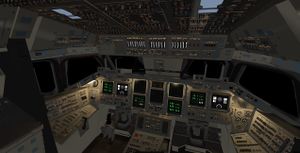
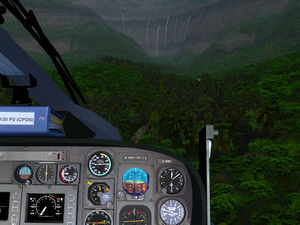
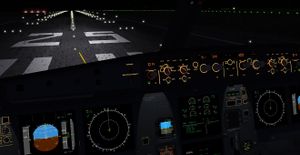
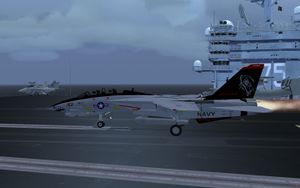
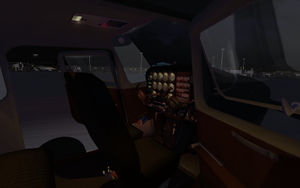
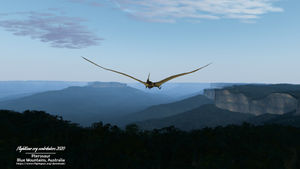
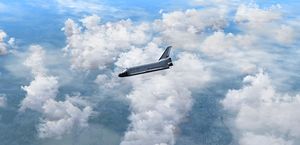
The preferred option to install the latest official aircraft is through the Aircraft tab in the built-in launcher, as explained in the following video. The remainder of this article describes the manual process, only to be performed when you don't use the aircrafts from the official FGAddon hangar.
Manual installation process
Aircraft packages are available on FlightGear.org Aircraft. These require unzipping software to extract from a compressed file format. Then these must be manually installed in a FlightGear software installation to use. The details depend on the method of download, operating system, and user setup.
Alternatively if you are using the nightly builds or a version controlled copy of FlightGear, or you wish to manage your aircraft collection using version control tools, the aircraft can be obtained directly from the official FlightGear aircraft repository - FGAddon.
Linux
(Ubuntu 12.04)
- Download the aircraft
- Create a directory to store your aircraft if you have not already done so. Make sure this directory is outside /usr/share/games/flightgear/. For example, use /home/{YourUserName}/FlightGear/CustomAircraft.
- Extract your aircraft file into the folder (the one you created above)
- unzip XXXXX.zip
- Start up FlightGear with Launcher. In Launcher, go to the Add-ons tab. In the Additional aircraft folders section, click the Add button and select the main folder for additional aircrafts (in our case /home/{YourUserName}/FlightGear/CustomAircraft). Now your plane should appear on the list of planes, otherwise restart FlightGear.
Now, you just need to unzip the next downloaded aircraft in the same directory and it should already be visible on FlightGear.
Macintosh OS X
First, We need to make sure that the FG application is in the application folder which can be done by simply dragging it into the applications folder from wherever it is currently located. Now let's get down to actually adding aircraft:
- Go to applications in folder
- Control+Click FlightGear
- Click the second option which reads "Show Package Contents"
- Then click on the following folders: "Contents >> Resources >> data >> Aircraft"
- Now just click and drag the aircraft data downloaded from the FG website in the Aircraft folder
(Works on MacOS Sierra)
Windows
- Download an aircraft and save it on your desktop.
- Unzip the file using a file archiver, for example the open source file archiver 7-Zip.
- Create a directory to store your aircraft if you have not already done so. Make sure this directory is outside your $FG_ROOT directory. For example, use C:\Users\{YourUserName}\FlightGear\CustomAircraft.
- Move the unzipped folder (usually the aircraft's name) to your that aircraft directory.
- Start up FlightGear with Launcher. In Launcher, go to the Add-ons tab. In the Additional aircraft folders section, click the Add button and select the main folder for additional aircrafts (in our case C:\Users\{YourUserName}\FlightGear\CustomAircraft). Now your plane should appear on the list of planes, otherwise restart FlightGear.
Now, you just need to unzip the next downloaded aircraft in the same directory and it should already be visible on FlightGear.
From the command line
Launching FlightGear from the command line, use the --fg-aircraft=path option, which in our case can be: --fg-aircraft=/home/{YourUserName}/FlightGear/CustomAircraft.
When installing an aircraft fails
Rename aircraft folder
If FlightGear fails to start with the new aircraft you have installed, or if it starts but the aircraft is invisible you might have to rename the folder where the aircraft files are. This issue is most often encountered when downloading a .zip file from some online git repository. In those cases you will most likely end up with a folder name of the following form MyZippedRepo-[branch]. In this case you should rename the folder to be just MyZippedRepo.
If the above doesn't work, or for other cases, check for a readme file and have a look there for instructions.
Otherwise open the aircraft-set.xml file and search in it for paths containing Aircraft/AircraftFolderName. The name of the folder should match AircraftFolderName.
For instance if in the imaginary-set.xml you would find an instance like this:
<splash-texture>Aircraft/MyCreation/splash1.png</splash-texture>
that means that you should rename the folder where imaginary-set.xml is to MyCreation.
XML files with wrong encoding
If you start FlightGear with the new plane you installed and there is no cockpit or exterior, this may be because the XML files are in the wrong encoding.
To fix this on Linux try this:
$ cd path/to/aircraft/directory/
$ find . -name "*.xml" -print | xargs sed -i 's/<?xml version="1.0" encoding="UTF-8"?>/<?xml version="1.0" encoding="ISO-8859-1"?>/g'
If any of the methods above do not work, ask around on the multiplayer chat, IRC or on the forum ![]() .
.
Choosing aircraft
If you are looking for information to decide what aircraft to download, try:
External links to third party aircraft can be found at FlightGear hangars. Remember that the latest aircraft may not load with previous versions. If you happen to use an older version of FlightGear, look for older aircraft in the links section.
Video tutorial by the community
Gallery (2017+)
Eurocopter EC135 showing rotor downwash on grass. (FG 2020)
de Havilland Canada DHC-6 Twin Otter over Alaska. Variants: floats, amphibious, and skis. (FG 2017)
Alouette-III has an AI simulation of an (intentionally imperfect) human copilot that can assist people learning to fly helicopters to take off and hover. (FG 2018)
Eurocopter EC130 on the slope of a shield volcano in Hawaii. The EC130 has the most detailed systems of helicopters available through FGAddon in FlightGear. (FG 2018)
Space Shuttle. FlightGear can show the view from orbit using Earthview - high resolution textures seen here are available as separate downloads.
Piper J-3 Cub is also suitable for training. The J-3 Cub features a G1000 glass cockpit variant, as well as float, amphibious, lite ski/ski, tricycle, bush variants in several engine sizes. (FG 2020.x, Compositor)
Robinson R44 is a popular training helicopter as it is inexpensive, but is hard to control. In simulations, expense does not matter. People trying a helicopter in FlightGear for the first time should try one of the other ones before the R44, unless they have a specific reason to. (FG 2019)
